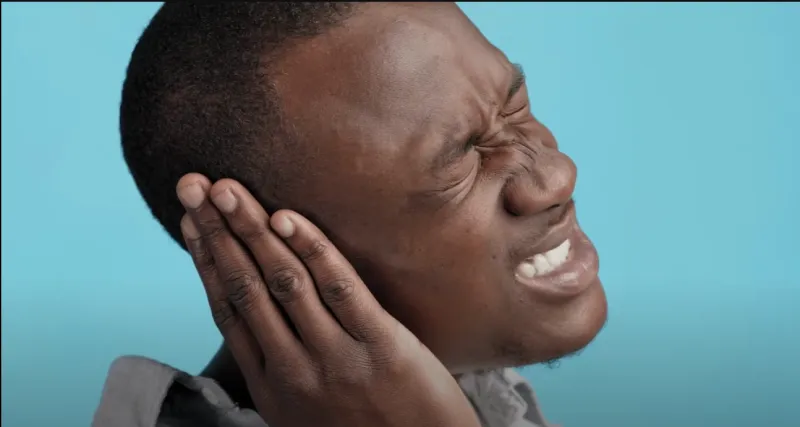Ear infections can affect cyclists’ balance and coordination, increasing the risk of accidents. Pain and discomfort from ear infections can make it hard to focus on cycling. Temporary hearing loss from ear infections may pose safety risks, hindering cyclists’ ability to hear important sounds.
Yes, ear infections can cause head pain while cycling. A shared nerve network between the ears and surrounding head areas can lead to increased pressure, resulting in ear pain during cycling. Inflammation and fluid buildup from the infection may exacerbate this discomfort.
In this blog post, we delve into the symptoms, causes, and risk factors linked to ear infections that lead to head pain during cycling and provide insights into preventing and managing ear infections and head pain while cycling.
Can Ear Infections Cause Head Pain While Cycling? Learn How

Ear infections, like middle ear or labyrinthine infections, often cause earaches and balance issues. Cyclists may worsen symptoms with altitude changes, air pressure shifts, and physical strain. For those prone to ear infections, frequent headaches while cycling are common. Explore how your ears impact your favorite activity in an enlightening journey.
Understanding Ear Infections
Ear infections are common ailments, especially in children, but they can affect people of all ages. Usually, they are caused by bacterial or viral infections of the ear, causing inflammation and fluid buildup. Here, we’ll explore the types and definitions of ear infections, as well as the common symptoms associated with them.
Definition and Types of Ear Infections
Ear infections are common ailments affecting many. Understanding the definition and types is crucial for proper care.
Middle Ear Infection (Otitis Media):
- Definition: A middle ear infection, known as otitis media, occurs behind the eardrum, where the ear’s tiny bones are located.
- Causes: It is often caused by bacteria or viruses that reach the middle ear through eustachian tubes.
Labyrinthitis:
- Definition: Labyrinthitis is an inner ear infection that affects the labyrinth, a maze of fluid-filled channels that control balance and hearing.
- Causes: It is usually the result of a viral infection, although bacteria can also cause it.
Common Symptoms Associated with Ear Infections
Ear infections can bring about a range of common symptoms that are important to recognize. Here are some symptoms of a cyclist’s ear infection. Understanding these signs can help in timely identification and proper management.
- Earache: The most common symptom is a pain in the ear, persisting or intermittent and ranging in severity.
- Balance: Particularly with labyrinthitis, balance can be significantly affected, leading to dizziness or vertigo.
- Hearing Loss: It can be caused by middle ear fluid buildup or damage to inner ear structures.
- Fever: Especially in children, fever often accompanies a middle ear infection.
- Fluid Drainage: There might be a clear, yellow, or bloody discharge from the ear, indicating a possible ruptured eardrum.
- Tinnitus: An ear ringing or buzzing sound can occur, particularly with inner ear infections.
- Nausea and Vomiting: These symptoms are more familiar with labyrinthitis due to its effect on balance.
Potential Exacerbation by Existing Ear Infections
Cyclists who have an ear infection might find these issues even more troubling. Here’s why:
- Increased Sensitivity: An ear infection can make your head more sensitive to movement and pressure, worsening pain from dehydration, neck strain, or a tight helmet.
- Balance Issues: Inner ear infections like labyrinthitis can affect your balance, making it harder to maintain proper cycling posture. This can lead to more strain on your neck and head.
- Inflammation: Ear infections cause inflammation, spreading to nearby areas, including the head, exacerbating head pain.
Risk Factors for Cyclist’s Ear Infections

A cyclist’s ear is particularly susceptible to infections, attributed to prolonged exposure to wind and moisture and the pressure changes experienced during rapid descents. Here’s what to watch out for:
Impact of Physical Exertion on Symptoms
- Physical Stress: Intense cycling can put stress on your body, which might worsen your ear infection symptoms.
- Increased Circulation: When you exercise, your blood circulation increases, which can spread the inflammation from the ear infection to other parts of your head, causing more pain.
Changes in Altitude and Air Pressure
- Altitude Changes: If you cycle in areas with varying altitudes, the elevation changes can affect the pressure in your ears, making an existing infection more painful.
- Air Pressure: Cycling in windy conditions or at high speeds can change the air pressure around your ears, potentially worsening the symptoms of an ear infection.
Manage Cycling Head Pain Caused By Ear Infections: Prevention
Preventing ear infections and managing head pain can make your cycling experience more enjoyable. Here are some helpful tips:
Maintain Ear Hygiene:
- Gently clean your ears to prevent wax buildup. Infections can be caused by bacteria trapped inside.
- Ensure your ears are dry after swimming or showering to avoid moisture that can cause infections.
Avoid Upper Respiratory Infections
- Common colds and flu can lead to ear infections. Keep your hands clean and avoid sick people.
- Eat a balanced diet, sleep well, and exercise regularly to strengthen your immune system.
Importance of Staying Hydrated and Proper Helmet Fit

Proper hydration and ensuring a well-fitted helmet are crucial factors for enhancing performance, preventing injuries, and promoting efficient recovery among athletes involved in competitive sports.
Stay Hydrated:
- Dehydration can cause headaches. During, before, and after your ride, drink plenty of water to keep hydrated.
Ensure Proper Helmet Fit:
- A helmet that fits well can prevent pressure points and reduce the risk of headaches. Adjust the straps and padding for a snug but comfortable fit.
Tips to Manage Ear Health While Cycling
Keeping your ear health in check while cycling can help prevent head pain. Here’s how you can manage it:
- Monitor Physical Exertion: Pay attention to how hard you’re pushing yourself. Take breaks if you start feeling more pain.
- Adjust Cycling Routes: If you have an ear infection, try to avoid routes with significant altitude changes.
- Protect Your Ears: Wear appropriate gear to protect your ears from wind and cold air, which can help maintain stable air pressure around your ears.
When to Seek Medical Advice
Symptoms that are severe or persistent should be reported to your doctor immediately:
- Persistent Symptoms: See a doctor if your ear or head pain disappears.
- Hearing Loss: Any hearing loss should be checked by a healthcare professional.
- Balance Problems: Difficulty maintaining balance can indicate a more serious issue and needs medical attention.
Following these tips for prevention and management can reduce the risk of head pain and ear infections while cycling, leading to a more enjoyable ride.
Conclusion:
Balancing a passion for cycling with ear health requires finesse. Understanding the risks and taking preventive actions against ear infections can simplify this juggle.
Whether it’s maintaining ear hygiene or ensuring a well-fitted helmet, these small steps yield significant benefits.
Yet, if persistent symptoms like hearing loss or balance troubles arise, seeking prompt medical guidance is crucial. Every cyclist is unique; healthcare experts’ tailored advice and care can elevate your cycling journey.
FAQs
Does An Ear Infection Cause Brain Pain?
Yes, an ear infection can cause brain pain if it spreads to the brain. Symptoms may include severe headaches, confusion, and changes in mental status. It’s important to seek medical attention if experiencing these symptoms.
Which Of These Ear Infections Is The Most Serious?
The most serious ear infection among those listed is meningitis, which involves an infection of the brain membrane. Aspiration of pus or blood, mastoiditis, and eardrum tearing are potential complications, but meningitis is the most severe.


